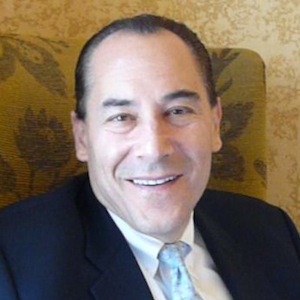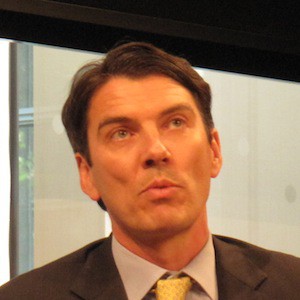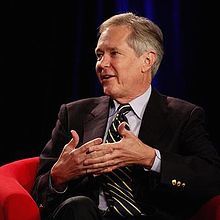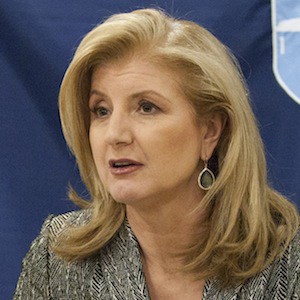Paul: It is April 8, 2013. We’re in San Francisco with Art Kern. It’s Paul Sagan and Martin Nisenholtz. Good to see you again.
Art Kern: Good to see you guys.
Paul: Maybe you could back up and just do five minutes of resume first that sets the scene, before what we came to call new media happened. You had a legitimate media background before the illegitimate new media came along.
Art: As I was telling Martin, I started out as a media buyer at Grey Advertising, not knowing anything about anything in media. From there, moved into the selling side of television, first starting in Pittsburgh, Pennsylvania with Westinghouse, KDKA TV. KDKA, as you may know, as the radio station that claimed the first commercial broadcast in the U.S in broadcasting. It was the Cox Harding election returns, 1920. It had a rich heritage. That company had a very rich heritage, as you know. I moved up in sales and management positions to, ultimately manage TV stations for them, first in Baltimore and then out here in San Francisco. Now, we’re in 1980. At that time, in 1980, I also started my own radio company with a friend of mine. We bought a radio station on Long Island called WALK 97.5, from the estate of Chet Huntley and three other people. One person was alive at the time. Then we built that into a commercial FM radio group, which we sold in the mid nineties. We had a couple of stations in Ann Arbor, Michigan and subsequently sold those. At about the time we sold the company was the time that I started at Yahoo.
Paul: What was your first experience when you say this online thing happening? And said, “This either changes everything or at least it’s really different, so I’m going to go there.”
Art: First, I would say that if I hadn’t have been lucky enough to sell my company at that moment in time, I was paying attention to it, but I wouldn’t have devoted the next chapter of my life to it. So having the time to dig into it and invest a little of what I’d earned in radio, into the Internet, gave me the chance to look into it. The very first investment I made was in a game platform company. It was called Total Entertainment Network. It’s now called Pogo and is a little, tiny part of EA. But at that time, what occurred to me was, “Oh God. This is going to change everything.” Of course, games looked like the perfect thing to do. Because you could connect up thousand of people in real time.
Paul: That would have been ’95?
Art: Yes. It was actually through that, indirectly, that I came to Yahoo. Because Mike Mortiz, who was the venture capitalist who’d backed Yahoo, was looking for someone who’d had media experience. Because he saw Yahoo as much as a media company as it was a technology company.
Paul: What was your first interaction with Yahoo?
Art: Mike called me up and said, “I’d like you to meet these guys.” I said, “What’s the business?” He said, “I can’t really tell you that much, other than it’s a directory for this new thing, the web. You’ll just have to come down and see these guys.” So I drove to the Valley and met Tim Koogle, Jerry Yang and David Filo. And Jeff Mallett, actually. I came away from that meeting feeling like, “This is very different, in every respect.” Something I might be able to add a little value, coming from the media side.
Paul: Mostly at that point it was a human guide?
Art: That’s actually the thing of it. People forget that Yahoo’s roots were both, but it was a human company and had human beings sorting websites.
Martin: Do you remember the technology intersection? These are two Stanford students who created it, so what was the technology doing? Was it managing the humans?
Art: What I remember…
Paul: You said both, so one was the humans. The both, the other was…
Art: Technology.
Paul: …technology.
Art: Because you needed both. Yahoo started out as a list, literally, a list of Jerry and David’s favorite websites. [laughs] They quickly asked their friends and it multiplied obviously geometrically. In fact, actually, by the time I got there, which was early ’96, I joined the four, January of ’96. They had already aggregated something on the order of 200,000 websites across 20,000 categories. The human side of it was how to categorize what was found and discovered. The discovery side of it came through spider, what you might call bot work. They had algorithms. They had to have algorithms to accomplish even that and they were well aware that this thing was going to explode astronomically.
Paul: So you had this first meeting and you realized something was very different.
Art: Yes. That something was first, they were extremely smart. You and I came from the broadcasting business. We thought we were smart. Had we met some of these Valley types earlier in our career, we might have had a lower opinion of ourselves and the work we were doing. Literally, as a matter of fact, Jerry and David were rocket scientists. They did some work with NASA Ames and they were PhD candidates. That’s the first thing that struck me, was how smart and nimble they were. They were scientists in the sense that media people rely on emotions, judgment, and intuition, all these good human qualities. Scientists have a very objective way of sorting out problems and that was very appealing to me.
Paul: Let’s come back to that engineering piece a little later, because I do think that’s very important in the collision of journalism and news.
Art: And a collision it was.
Paul: Yeah, exactly. But in that moment, so this barely a media site, it wasn’t all technical and it certainly wasn’t a news business at that point.
Art: It didn’t intend to be. There were a group. I think when I got there, there might have been 30 of these. They really weren’t editors. I forget the name we used, but they were in the business of categorizing the Web.
Martin: Which is an editorial function.
Art: It is.
Martin: A curation function.
Art: A curation, exactly. If you think of it today though, you could accuse them of hubris because how could you possibly scale that up? Everybody was aware that that was going to be a central question. How do you scale that up? It had to automate fairly quickly. Nonetheless, for many, many, years, that was the question you asked, for many years that was the DNA of the company, were hundreds of these human beings. Several hundred…
Paul: …who weren’t, or at least there primary job wasn’t being computer scientists or engineers.
Art: Not at all.
Paul: They were curators or…
Art: Curators.
Paul: …or a form of editors. Something happened along the way. Either the scale just got too big or the engineering side took over. It became more a tech company, but it also became a news and information business. Talk about how that happened.
Art: Yeah. By the way, I should footnote this part of the discussion as saying, this question of is Yahoo a media company or is it a technology company, was both the great opportunity for Yahoo and also it’s greatest milstone. By having to be both for so long, it slowed the company down in many, many, ways and we can come back to that. That was a central problem for the company. So, in any event, on the human being side no one intended for Yahoo to originate content. We were an aggregator. We saw ourselves as the place to kind of get this chaotic Wild West web thing organized for you. And, of course, over time quickly that drew in mail, which, because so much of information is contained or relayed within mail, you know, today’s form are tweeting and texting and all the rest. But mail was central.
I think we were the first that did this. We were copied by Google and others, which was very flattering. We created this product called, “My Yahoo,” which was, again, consistent with this idea that we were trying to organize the flow of information to you, personally. So the My Yahoo service, which still exists today, I still use it.
Lucky for Yahoo that the New York Times, the Wall Street Journal, and several thousand other great publications modularized their information so that you didn’t even have to read a complete Wall Street Journal or New York Times. You could pick technology and op ed, and national and international, put these modules on My Yahoo, have them fed through RSS, and all of a sudden you’ve got the best of everything coming to you through that product.
Paul: So talk about how that product came together in the first deals, because there has been in some of the current debate or thrash almost this concept that those media companies committed original sin when they gave away content for free. That’s the pay wall versus no pay wall. You could almost argue that fundamental sort of unleashing of news on the Web was providing these feeds to Yahoo.
Art: OK, so I can’t tell you exactly how each deal unfolded. What I can say is that back then all of us, everybody, Martin, I’m sure you would agree with this, we were in a foot race, and you know journalism is always a race to get the story, get it right, hopefully, but get the story. And this race involved aggregating eyeballs which was almost like mortgage backed securities in a way. The whole idea was to get as many eyeballs as you could and worry about the implications later. So I don’t think through the lens of looking back from today, that it’s fair to say something bad was unleashed. I think it just was. It’s what had to happen, and everybody was in the race. Everyone. Yahoo had multiple competitors in this foot race. And then, of course, the idea was to aggregate the user ship and then sell it in the form of advertising and various ways. And, of course, underneath this foot race Google came along. Yahoo had always used the best search technology under our label, because we didn’t think that this was something we either needed to do, or, I should add, we were necessarily good at.
Martin: Was that initially AltaVista?
Art: Yes, we had whole series of them. OpenText was one. Some of the names I forget. As we took shape as portals, Excite was a big one, search became an incredible component, and you can’t ignore it in this discussion, because search helped drive the outcome here. So, in looking back Google was a game changer. We knew they were the best, and we knew just as newspapers lament opening up content to us, we lament opening up that search position to them, but we had to.
Martin: Actually, just to clarify, there were two phases. There was the pre RSS phase when we at, the Times, did a person to person business development deal with Yahoo…
Art: Right.
Martin: …and we would give you one or two full text articles that you could run in return for the links. And we were very happy with that agreement. The other was the post [RSS], where you would just take the feed. But, I wanted to ask you a question about Yahoo Finance, because, to me, Yahoo Finance was the first really interesting software based web news product. I mean it wasn’t just…
Art: Right. It wasn’t just aggregation, pure aggregation.
Martin: Right. It was you guys had all these tools and interesting ways. And I think that set the tone for Yahoo’s early development of content, and for whatever reason, and this goes back to Paul’s point, the engineering piece was just lost on the traditional media companies. They could not add value to their content in the way that Yahoo was doing it, not during that era. So could you talk about Yahoo Finance? Do you remember it?
Art: Yes, I remember it well. My Yahoo is one of our signature products. Yahoo Finance was as well. And we came to find out later, very interestingly through market research, that most, and I think this still exists today, though it’d very interesting to test, of the really, really, accomplished in investment banking, banking, financial services, etc. had two screens on their desks, the Bloomberg screen, which never did, by the way, get disrupted by the Web. Everybody thought it would once the floodgates opened, because free would take it over, and Bloomberg charges quite a bit for those screens, for those [indecipherable 15:49] . The two screens were the Bloomberg screen and Yahoo Finance, and why Yahoo Finance? Because it started, it was the earliest, it was the pioneer product.
And it gave you a little of everything, and, again, aggregated, because that is Yahoo’s DNA, but, nonetheless, simple. Some would argue that it should have progressed into being a lot deeper and lot more of proprietary product, journalist product, but that, again, we weren’t good at it, and we wanted to leave that to others. But it’s great that you bring it up, because it was important for us, and, amazingly, it’s still doing well, but, of course, now you’ve got 100 other competitors.
Paul: Do you remember the Reuter’s deal? That in our research has come up, and David Graves, we’ve interviewed sat on both sides.
Art: I hope he can fill in the specifics.
Paul: He filled in a lot, but he talked about it first having done the deal at Reuters and then went to work at Yahoo.
Art: Yes.
Paul: I was wondering if you remembered that deal, not necessarily the details, but just when that happened, because it also set all the general news kind of free on the Web and in real time.
Art: I do think that was a landmark deal for Yahoo. On the one hand it brought all that content, access to that content, worldwide, and by this time we were already worldwide, but we needed to be completely global, and Reuters, if nothing else, is a global news organization. And so, yeah, I think it was crucial for us. I don’t know the details of it. We were happy to have it. Along the way, there were some issues about whether Reuters was happy with Yahoo, but there’s a…
Paul: Sounds like from his version, just to fill you in, there was a little Innovative Dilemma on their side, but his group won. There were some people there a little unhappy.
Art: Internally.
Paul: Internally, but they were basically, a wholesaler, unlike AP, which was prohibited for a while from cutting those kinds of deals, and so even though there was some unhappiness at Reuters they were able to cut the deal with Yahoo.
Art: Well, the flip side of all this is the newspaper consortium that Yahoo ultimately ended up in a deal with, and as a director I remember saying this to many different people over different years, that Yahoo was the one web company that preserved, not just the appearance of wanting to support journalism in newspapers in particular, but the actuality of it. We wound up that deal, I don’t know how much this has come up in your prior discussions.
Paul: No, so you should go into a little detail.
Art: Well, the person you might want to talk to who has the clearest memory of this is Hilary Schneider, who ran digital for Knight Ridder, and ultimately came to Yahoo. The unwritten story about that is that Yahoo, because of it’s roots, I was thinking about this this morning on the way over, because of its roots, editorial roots in the sense that we had all those curators, it was a human, always has been, a human company. And so the human element in journalism still appealed to the company culturally. So this deal that Hilary really helped engineer was to form a real partnership with newspaper groups such that we could help them with their economics in two different ways. I think Hilary called it, “we sell, you sell.” But the gist of it was that each individual newspaper and each individual community didn’t have enough digital inventory to really have critical mass to go to the agencies and sell something that would make it worth their time to buy. So Yahoo had all this inventory spread, and obviously targetable, geo targetable, anywhere. So the idea was that our algorithms would allow us to add inventory to them so that they could package it, and their salespeople could sell it. And we made a commitment through Hilary, Hilary’s efforts, to train the local sales staffs at these local newspapers so that they could sell Yahoo inventory with theirs, and it would all kind of work.
It was a very human labor intensive, inefficient, low margin, business. It’s not what Wall Street wanted. It’s not what anybody wanted. Patch, I think, may be even harder for AOL. I’m not sure, as we sit here today, where that alliance stands, but there was some feedback from some of the groups, Meredith and Gannet, I think, and others, who said, “You know what? This isn’t bad. It’s a net positive for us.” So it was Yahoo’s efforts on behalf of that human culture to try its best to keep newspaper journalism alive because it already had been horribly hollowed out.
Paul: Do you recall if Yahoo ever thought it had to do more as a news organization meaning, did you need to build a newsroom? Did you have to have reporters? Did you need to have a brand?
Art: Always a debate. When Terry Semel came in as CEO in ’01, you know, my personal warning to him was let’s try not to get too much into original content, period.
Martin: Well, then he hired Lloyd Braun.
Paul: And went another way.
Art: Went another way, and this is not a criticism of Terry. In fact, it was quite a noble effort. He understood the economic shortfalls of getting into original content, not just in journalism, but, obviously, in entertainment as well. And he also understood, in his shoes he really understood all this, was that shorter bites, shorter length stuff, which ultimately took the form of YouTube, by the way.
Paul: Sometimes you can just be too early.
Art: Yeah, well, he was, and the company committed a fair amount of resources to L.A., which in retrospect maybe he’d say he wouldn’t. But Terry Semel was also the guy, and this is another irony. I’m glad we’re doing this because I’ve always wanted this to go on the record. Terry Semel came to Yahoo with a fresh perspective on the Web, so much so that he was criticized in the early days for not doing his own email, that kind of stuff. But what Terry was very quietly doing was trying to asses what the whole business landscape of the Web would look like three, four, five years later. And the conclusion he reached, and it took a media guy to reach it, was that if Yahoo didn’t become a principal in search, principal, not an agent, it would die. And after that, that was a seminal, or should we call it a Semel, moment in which the board realized, “This guy is right,” and the insiders hadn’t said that. We’d always gone along with changing engines in the car. And so after that the company committed on the order of over two billion dollars to acquire the assets of Inktomi and Altavista. We acquired tons of patents.
Martin: Acquired Overture.
Art: Overture, which was the…
Paul: Ultimately the deal.
Art: Ultimately the deal, and ultimately the pioneer that in that area that Google needed to replicate. They probably built a better version. In fact, I can safely say this now it was for sure a much, much, much better version.
Martin: Well, does this go back to the point about engineering? Did Yahoo lose its way as an engineering business under the Semel leadership?
Art: I would argue that it may have lost its way even earlier than that in the sense that we, again, back to this if you’re two different companies, media and technology, and there’s always debate about how much you want to commit to technology versus content and aggregation, you’re not going to have the same focus that an algorithmic company like Google would have.
Martin: Well, but this is a very…
Art: This is a truly central question.
Martin: Because what we’ve been told by some very smart people, including, I think, Mike Moritz, is that the problem that a lot of the institutional journalism companies have had is that they just don’t understand and respect the engineering side. I think one person said, “You can’t have innovation without engineers.”
Art: He’s right, and in my personal view as an ex media guy, that’s been my view all along that…
Martin: But then you’re saying you can’t have both. We hear that, too. We hear from the journalism side, “Well, we’re not engineers. Our DNA is to create journalism.” You know you almost can’t have it both ways. Either you’re going to do the engineering and focus there, or you’re not.
Art: Well, you see, that’s the same dilemma that applied to Yahoo in the early days applies to all media companies today. You cannot ignore…you must be in the technology business because your content is now being served in ways that are changing every minute, and you have to know how to serve your content. There just is no way around it. So I think that’s the great lament for content companies going forward. In a way, you guys have inherited the very mantle that Yahoo is sort of attempting to shed. Marissa Mayer is doing a lot of the right things. She’s getting the spirit of creating new ideas and this gets to a whole other subject about how small teams… I mean it’s almost a joke when we’d hear…believe it or not, Yahoo had a lot of very smart technology people embedded in it, but frustrated, and when we’d go directly to them as directors, we could talk to them in the hallways and say, “You know, how about this new product? How big a team do you have on it?” One of the guys I remember saying to me, “You know, it’s 10 people and it’s too many,” which, one could argue, could be Microsoft’s cultural problem from the get go.
Paul: You get bloat from big teams, and you get too much veto power.
Art: So when you talk about technology I think you really have to be talking about the culture of how this stuff gets developed quickly, and I can’t emphasize the word “quickly,” enough, because time’s the currency. People think it’s money. It’s really, in addition to brains, it’s time. You have no time to do anything unless you’ve got really smart people in very small groups doing very smart things. And then in the case of the web culture testing, retesting, always testing, always, and constant improvement, which is a culture which is not a cultural aspect of most media companies. In fact, what we grew up with, all three of us, is you put a message out. That’s why they call it broadcast.
Paul: Also, the newsroom culture is about speed but without errors, and beta implies that it’s not going to work.
Art: That’s crucial. And everything’s in beta all the time, really.
Paul: In tech.
Art: In tech.
Martin: I mean we’ve been using Google Hangouts.
Paul: For this, and it’s in beta for years.
Art: [laughs] Absolutely
Paul: Where a news organization, it’s counter cultural. So maybe we should go back to the search question.
Art: You certainly have hit the absolute center of this stuff.
Paul: Well, we lived it, too.
Art: Yes, you did.
Paul: So we’re sort of reliving it.
Art: So that’s why you know it. That’s why you can ask about it.
Paul: And the themes start emerging out of the discussions, and there’s a lot of consistency. You know, we haven’t met any dumb people or people who ignored what was going on. We’ve even met people who were visionary. They either were too early or their organizations couldn’t invest enough, well the analogy would be using a swimmer and the tide so a lot of these were very strong athletes, but the tide is just so strong.
Art: Exactly, which is why I don’t think we can look back at the newspaper companies, the media companies, and say they were dumb and they missed it. That’s not what happened. It was a collision, and the cultural, I mean I could do a thought experiment. How would I, if I were running a newspaper, change my culture enough to be deeply embedded enough in the technology to be nimble and to be competitive with companies like Twitter, who are hiring, by the way, the same people that I need to hire to innovate in the delivery of my content.
Paul: So let’s talk about search a little more and what happened, because it was so disruptive and technology driven, and it got married to a model that all of the originals, including Google, didn’t foresee. And it didn’t take some of the ad business online. It’s taken most of the ad business, right, the consolidation of ad revenue into search and then into one major player. For all the fears of consolidation of other media, this is unprecedented.
Art: Unprecedented. Again, going back to Terry Semel’s early days. Terry foresaw that. It’s simple mathematics. If you got the best algorithms, you ring most of the cost out of the aggregation business that you’re in. Here’s Yahoo, clunking along with all those human beings, trying to aggregate information, and here’s Google, another thing that I don’t think has been overstated enough. Google’s architecture, the way the launched anything new, was stunning. We didn’t know it quite at the time, but it didn’t take us long to figure it out. They set up the company with a vision that everything we do, we can do, if press one button here in the valley, it can roll out worldwide, instantaneously. Think of what kind of architecture it would take to do that. Among other things, they had strapped together these very cheap servers by the hundreds of thousands, literally. It’s the software that interconnected them that was brilliant. People forget that the architecture, you know this well, of how the data flows really matters. Again, back to the point about speed. Like Yahoo we’d have a, call it Yahoo Answers. We’d have a product developed by a small team in Taiwan or Korea.
Martin: Successful product, by the way.
Art: Yeah, fine. But first of all, look how long it took just to get headquarters to understand that it was successful, much less roll it out anywhere. Versus Google, who could have taken something like that and rolled it out instantaneously. I remember asking one of our engineers, “When we’re doing testing, how many servers do we dedicate to that task?” Proudly, he said, “5,000.” I said, “How many does Google use?” He said, “At least 100,000. Maybe 150,000.” Think of an exponential curve and think about our line, versus theirs. And how long it would take for them to zoom past us. Back to search, everything that they did was architected for speed and simplicity. They made it look simple, but they had the best algorithms, by far. That meant that they would be more accurate, they’d be more timely. In making the advertising case, it’s the same for the ads. They would be placed in the best context, which ultimately came to me, obviously, geo targeting, time of day and all the rest that lends itself perfectly to algorithmic analysis.
Martin: I want to get back to news and information for a moment. During the web 1.0, pre dot com bust era, Yahoo was or became the king of the portals. The notion that bundles…
Art: By the way, who invented the term, “portal?”
Martin: I thought you did.
Art: Beats me.
Paul: I don’t know. But it stuck for a long time.
Art: It sure did.
Martin: That notion of bringing everybody together in one place, which had been, by the way, the traditional media company role, moved over, to some extent, to Yahoo. Now web 2.0 comes along. The idea of going to one place disappears with Google. Because their job, paradoxically, is to get you out as fast as possible. They create this gigantic business that Paul references.
Art: Stunning, wasn’t it?
Martin: Yeah, stunning.
Paul: It is the miracle of the toll booth. If you get the toll booth in the right place, you don’t care where people drive after the toll booth.
Art: Exactly.
Martin: Now, there’s this notion that maybe there is a re aggregation taking place.
Art: By the way, there are no humans taking tolls anymore on the Golden Gate bridge.
Paul: It’s a machine.
Art: As of two weeks ago. It’s all Fast Track.
Paul: But you still pay.
Art: You pay.
Martin: [laughs] This is the employment conundrum.
Art: Exactly.
Martin: Anyway, is Twitter the new Yahoo? Is Twitter the new aggregation point in your mind?
Art: [laughs] It’s certainly an enabler. I don’t know that I’d go that far. The one thing that is interesting to me in looking back is how really what’s happened, the evolution from email to texting to Facebook to Twitter. If you think about what that natural line of progression is, again it’s time. Twitter is instantaneous. Time and of course obviously you can blast 1,000 people just as you can with Facebook. It’s time and it’s coverage, but does that give you everything you need? I would hope not.
Paul: Also, let me ask you if you also think it is one more thing, which is almost everything has been in the sequence we’ve talked about. I think for 20 years there has been an increasing fragmentation of the bundle, right? Yahoo broke it into categories and stores, Google into searches. You almost went from sites to pages to articles, almost to Tweets. They’re not even full sentences, they’re 140 characters. What can you express in 140 characters?
Art: Exactly.
Paul: The challenge for the journalist or the editor is, how do you fit in a world where people are looking for your sentence or your paragraph, not even your story section and certainly not even your brand?
Art: See, my worry, I’m not 20, so I don’t know how 20 year olds process this going forward or how future 20 year olds process it. There has to be an upper limit, not to mention some kind of personal evolution. My wife doesn’t use Facebook anymore. She’s younger than I am. She used to use it prolifically and then it became too noisy for her. I think this noise factor, this is just a personal opinion, will make a difference over time to people. It’s almost like staring at the sun or taking too much radiation. You have a lifetime dose you can take in a certain part of your body. I think at some point, there may be a lifetime dose of Tweets. You wakeup one morning and say, “Oh my God, what happened to my life? How much of this is really meaningful?” Now that’s not to say we’re going to go back to people reading the paper the way they used to. That’s just not possible. There is something that’s going to change again and it’s going to change again, so I don’t see it as an aggregation point. We used to say, having had experience in most major old media, one of them was outdoor advertising. The hardest thing to write copy for by far was outdoor, because the average read on a billboard is less than a second.
If your message doesn’t come in in less than a second, it’s inferior. That’s why most outdoor advertising is pretty inferior, actually. The good ones really leap off the board. To the extent that we’ve got Tweets resembling outdoor advertising, it will be around.
Martin: Some people talk about them as headlines, new forms of headline writing. In fact, some of the folks we’ve interviewed have said that. I guess the question in relation to the news and to Yahoo is, if Yahoo once was that point of aggregation, is there a natural new point of aggregation? Some people have postulated that that new point is Twitter, because people do like…
Art: Maybe so. The best people to ask, obviously, are the people who Tweet often, early and often. Again, beware because they may not have yet reached their own personal lifetime dose. I don’t know.
Paul: If you think we’ve covered the Yahoo story, I do think we ought to cover the digitas story for five minutes. Because that was the other important piece of the new world that you really spent time in. Advertising has been pretty central even now as it some ways declined is important to the news sites. Billions of dollars shifted and you saw that happen and understood that, too.
Art: Yeah. It’s the underpinning for all of this, ultimately.
Martin: Well, talk about Digitas, because you had mentioned Digitas as part of your background.
Art Kern: Right. I went on the Digitas board ahead of Paul, but not that much. Well, we went public.
Paul: So, enough?
Art Kern: It was Bronner Slosberg Humphrey. Digitas was one of an emerging group of younger agencies that weren’t saddled with having to think the old fashioned way about broadcasting messages and all the rest. They understood the web as a platform, they had to. Everybody in that shop had to be like Google, as you were saying Martin. The very people you need to deliver the content from conventional media have to be digitally savvy. That’s a mind shift. Paul and I were talking about this earlier. A lot of people who came from our side of the fence, many of them, I saw waves of them coming into Yahoo in the early days. Many of them didn’t make, because they couldn’t grok the idea that the web was completely different in the way people consumed it and used it. Digitas was, presumably, loaded with people who did understand it, and whose advice the agencies and advertisers needed. David Kenney, who built it, really built it, but Michael Bronner started it.
Actually, the way it worked was, there was a digital division. I forget the name of it now. This is terrible. But it was run as a smaller unit, culturally different from the larger, the roots of Digitas were direct marketing.
Martin: Yeah. Because Bronner won the American Express business when I was at Ogilvy. That was a big deal.
Art: There you go. And Michael’s insight was that personalized, targeted messaging was the future. And what a natural fit for the web. Within the belly of the beast, this, it was run by Kathy Byron, I’m trying to think of the name of it. In any event, that little division, the question was, “Do you spin it out? This or that?” At the end of the day, Digitas was born as one integrated, digitally savvy marketing agency. David Kenny took it from there and built on everything that Michael had built. Again, a lot of the questions there. Here’s what’s really interesting to me. I’ll just say this as an ex media buyer. When I started at Gray I made, you’ll always hear this, $125 a week. My job was to buy radio and TV time for Canada Dry. I was looking at demographics and stuff. I did everything manually and in a hurry, because Gray was in a hurry in the sixties. By the time I became a director at Digitas, the media department had become as important as the creative department. Why was that? Because we had fully entered the data driven era, this digital era. And we were only beginning. This is the really interesting part.
What are we going to do about big data in every aspect of our lives? Google’s just a sneak peek, in a way. Because everything, from health care to insurance, everything else, is going to be driven by massive amounts of data that we don’t know how to understand.
Paul: I want to ask you one last question about the ad business.
Art: Yeah. Sorry to get off, but that’s where Digitas and many of the agencies are going to need even greater expertise.
Paul: And they find that they don’t have nearly enough technical expertise?
Art: Precisely.
Paul: That’s what history would suggest. My question though, was around inventory. The world that we came out of, the pre online world, was absolutely about scarcity. The web world has turned out…
Art: Those were the great old days.
Paul: The great old days, when you could bundle and you knew you did really well when you had one spot left. It meant you priced perfectly. Now we’re in a world of truly infinite inventory. It’s having a dramatic impact on ad rates. One of the hopes for free content, which was that the market would mature and be big enough that advertising would support it, seems to have backfired. Did you see that tipping point, did you have an insight into that?
Art: There was no question that the inventory was going to multiply at the same geometric rate that users were multiplying, no question. The issue always was how to, first of all, set up pricing algorithms so that you could get the absolute most out of what you had, packaging and otherwise. Yahoo’s front page was the premium place to be. It still is. But, to your point, you can buy the web by the pound, literally. That’s only going to continue. That’s why you have these ad exchanges where inventory can be parsed and segmented and sold by the pound as a commodity. It’s completely commoditized, quite a bit of it. That said, the counter trend that may be developing, and should, over time, is context. The holy grail is to get the right message to the right person at the right time in the right context. This big data world we’re entering gives you a lot of context if you can master it, figure it out. The best agencies will be able to deliver on that promise in increasing ways. The inventory that gives you that, optimizes for that, may be worth a small fortune. While the bottom part of the pyramid, you’re right, it’s gone, it’s commoditized, the top part of the pyramid may be worth a whole lot more. I say that because I think it’s well underway, a lot of this.
And the experimentation, the tinkering that’s going on now is stuff like when you went to restore, do you get customized offers in aisle three. I mean, that’s happening now, all this check in stuff. And again, back to the question, what’s the upper limit of what a consumer can take? I mean, I’ve tried dozens of these, and most of them, I’m maybe too old to adapt to that world.













